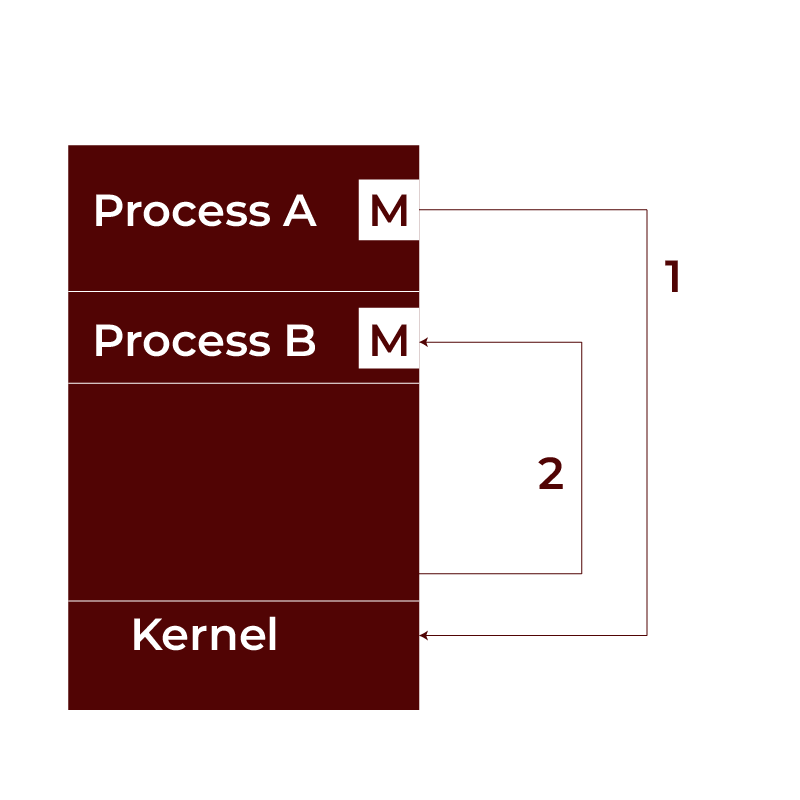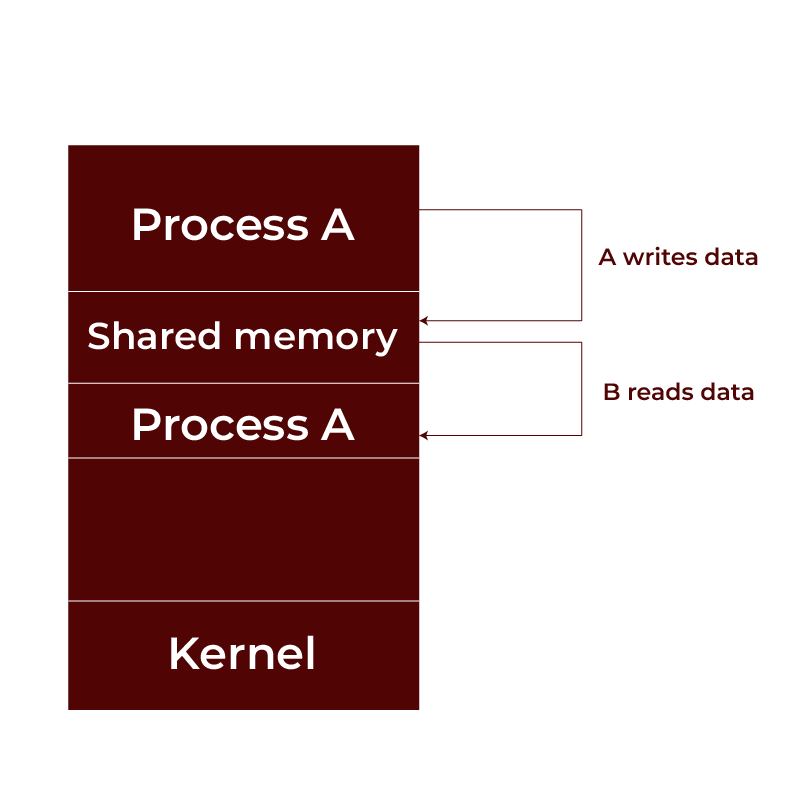There is a need for the processes in the operating system to communicate with each other. There is a term for that: Inter Process communication. Are you interested in learning more about how it is done? Then, read below, because this article will describe how inter process communication can be achieved. One of the important mechanisms used by an operating system to achieve these goals is inter process communication (IPC). IPC allows processes to communicate without using user-level routines or interfaces. It prevents different parts of a program from accessing shared data or files from interfering with each other. Messages are exchanged between two or more processes in inter process communication. They can be in different machines; processes can be on the same computer. This article will discuss the IPC, its importance, and different approaches to achieving IPC.
Inter Process Communication
Inter Process Communication (IPC) is the mechanism to exchange data and information between more than one process. The processes from these lines can be put on the same computer or distributed on different computers hooked to a network. IPC is an important part of computing and provides the process of communicating, synchronizing, and sharing resources. Multiple tasks rely on IPC. It first provides the capability to share data among processes so that, in a controlled way, processes can read and change the data shared between them. In scenarios where multiple processes must interact or access a data set together, it is necessary. Second, IPC is used to coordinate activities so that processes run Their stuff together without conflicts. With this coordination, data integrity would improve, and tasks would be executed seemingly unattended.
In addition, IPC participates in resource management. It allows processes to use system resources such as memory and files and to distribute them efficiently. IPC also supports modularity, which means that different parts of a system can work independently but share when necessary. This modularity permits developers to create more complex systems out of a few smaller, specialized components.
Also Read: Process Synchronization in OS

POSTGRADUATE PROGRAM IN
Multi Cloud Architecture & DevOps
Master cloud architecture, DevOps practices, and automation to build scalable, resilient systems.
Types of Inter Process Communication
A system typically has two types of processes: independent and cooperating.
- Independent Processes run independently, so the execution of one process does not affect the execution of another. Here, systems operate in isolation and do not share data or information with the other process.
- Cooperating Processes: However, cooperating processes may influence the execution of other cooperating processes. Data and information are shared and processed collaboratively. Through this cooperation, these improvements raise computation efficiency and facilitate modular design and resource utilization.
One might think that independent processes run at peak performance, but cooperating processes can increase overall computation speed by ‘bandwidth multiplexing’. This often results in higher performance and functionality, as tasks can be divided and executed in parallel.
Inter Process communication (IPC) means how these processes can talk and align actions. IPC is used for processes to cooperate in a manner which helps them work effectively together. Processes can communicate through two primary methods of IPC:
- Shared Memory: Fast data sharing and communication use multiple processes that have access to a common memory space. However, careful synchronization is needed to avoid conflicts and maintain data consistency.
- Message Passing: Here, processes communicate with messages they send and receive. Each process has its own memory space, and without having to share any memory directly, they can share information between themselves. Processes running independently make message passing easier to manage in synchronization.
The advantage of cooperating and synchronizing processes in a concurrent processing setting cannot be achieved without IPC using both methods.
Synchronization in Inter Process Communication
Interprocess communication (IPC) synchronization guarantees that several processes or threads can access the shared sources of data in an orderly and controlled way. It coordinates process execution via mechanisms such as semaphores, mutexes, or monitors, all of which prevent problems such as race conditions, where processes mess up with each other’s business. It will ensure consistency and prevent conflicts on concurrent access.
- Mutual exclusion is a way to ensure that only one process can access a shared resource at a time. It’s usually implemented with a lock, a data structure that indicates whether a resource is available.
- Condition variables: These are variables that wait for certain conditions to be met. For instance, a process can wait until a shared resource is available before using it.
- Barriers: These are the synchronization points that all processes must arrive at before they can do anything else. When used, they ensure that all processes have completed one task before proceeding to the next task.
- Semaphores: These are the variables used to count the instances when a shared resource is being used. This can also ensure that a resource is used as much as possible at a time.
Approaches for Efficient Inter Process Communication
Message Passing
Message passing is another important way in which interprocess communication is possible between other processes. If two or more processes are engaged in interprocess communication, they send messages to each other through the Kernel. Here is an example of sending messages between two processes: This message is sent to the OS kernel here, as the process is sending a message of ‘M’.
The process sends the ‘M’ message to the OS kernel.
Successful message exchange between the two processes requires a communication link. There are several ways to obtain these links.

Shared memory
Two or more processes are established using shared memory. Each should protect this type of memory from each other, synchronizing access among all processes. A and B processes can create a shared memory segment and share data through the shared memory area. These are reasons why shared memory is important:
- It is a way of easily passing data between processes.
- These methods are much slower and less reliable than shared memory.
- Two or more processes share the same copy of the data.
If process A needs to attach its address space to that shared memory segment and communicate with process B, it will do that. In this case, Process A writes something to that shared memory, and Process B will read from that shared memory. This is why synchronization is important (so both processes don’t write to the same location at the same time), and thus, processes control this.

Pipes
Data channels used for one-way communication between two processes are called pipes. This is a half-duplex technique so that the primary process will communicate with the secondary process. Because this is a half-duplex technique, the primary process communicates with the secondary process. Some extra lines are required to get a full duplex. The two pipes create a bidirectional data channel between the two processes. One pipe, however, causes a unidirectional data stream. Pipes are mostly used in Windows operating systems. In the diagram, one process will send a message to the pipe. Another process will read the message and write it to the standard output.

Signal
A signal is a facility through which processes communicate with one another. It tells a process to do something, allows one process to send a signal to another, and allows one process to interrupt another.
Also Read: What is the Process in OS

82.9%
of professionals don't believe their degree can help them get ahead at work.
Advantages of Inter Process communication.
- It allows one application to control the other and supports glitch-free data sharing.
- Inter Process communication ensures that we can send messages very well between processes.
- As the program is divided into separate sections of code, it is easy to maintain and debug.
- Other things that programmers can do simultaneously are edit, listen to music, compile, etc.
- Different programs can share data at the same time.
- Special types of processors can be run with subdivided tasks. Then, data can be exchanged through IPC.
Disadvantages of Inter Process communication.
- They also need help to write to similar locations.
- Processes or programs using the shared memory model need to write to shared memory locations so that they don’t write to the same location.
- Problems regarding storage synchronization and protection in shared storage models must be solved.
- It’s slower than a direct function call.
Conclusion
A key component of modern operating systems is Interprocess Communication (IPC) which allows processes to share data, coordinate, and manage their resources. IPC technique includes shared memory, message passing, synchronization methods and signaling, etc, to achieve easy communication and cooperation between independent or cooperative processes. IPC has some advantages, especially patience and parallel tasks execution, but there are also synchronization and conflict in data issues. These mechanisms and their implementation need to be understood in order to optimize process interactions in such a way as to contribute to the efficient performance of the system.
What is Inter Process Communication(IPC)?
How does IPC work?
What are pipes in IPC?
Can you describe the socket usage in IPC?
What are remote procedure calls or RPC in IPC?
Updated on October 15, 2024
